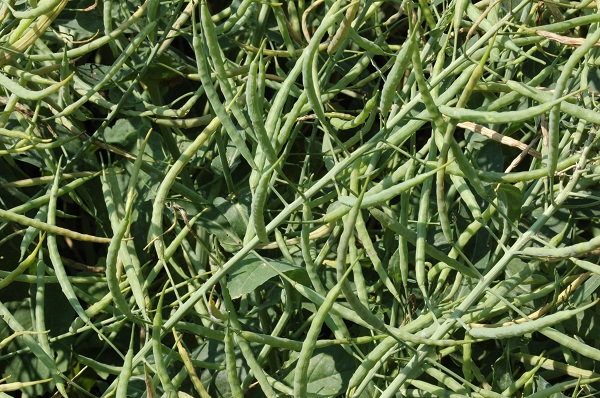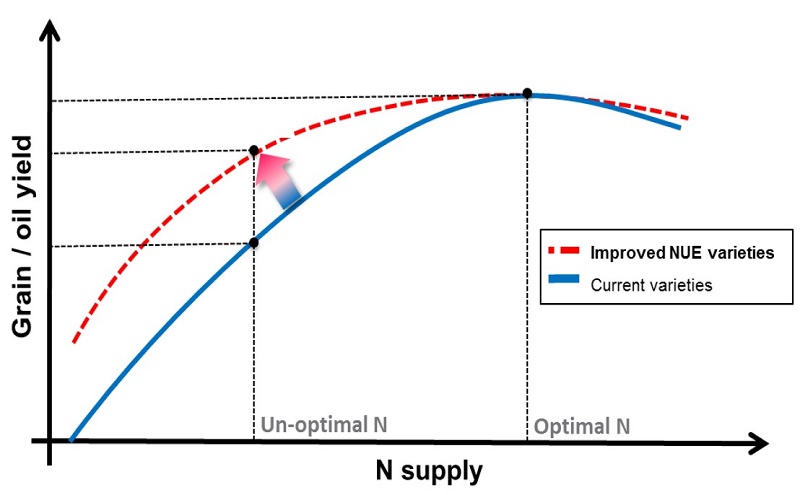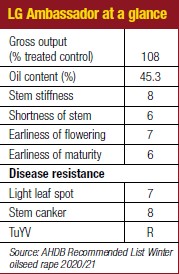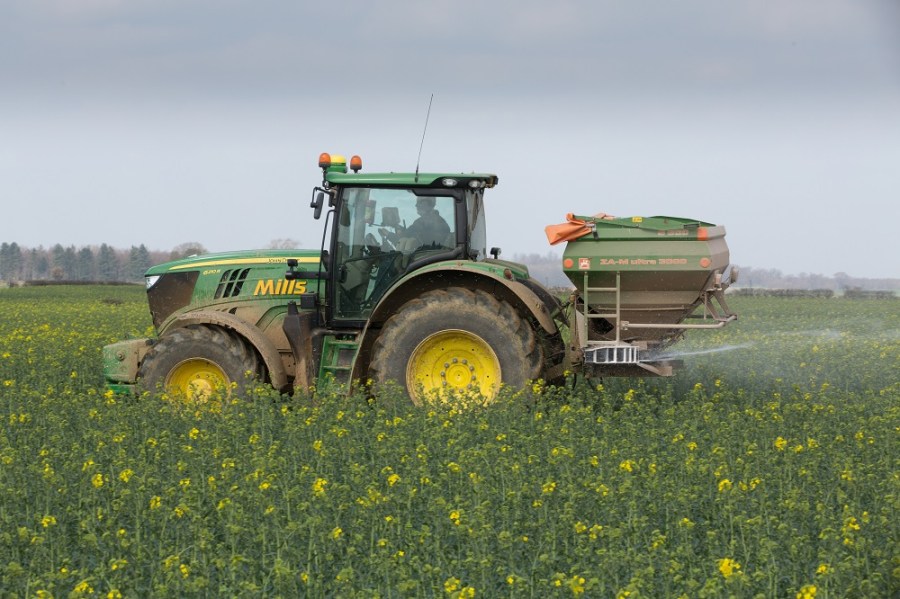Traits are increasingly becoming the route through which breeders deliver genetic solutions to agronomic challenges in oilseed rape. CPM explores N-Flex, a new trait from Limagrain designed to help optimise nitrogen inputs.
The trait is becoming the standard ideotype for assessing an OSR variety.
By Tom Allen-Stevens
It’s perhaps one of the most frustrating aspects of growing oilseed rape. You’ve given the crop everything it could possibly need at the right time, yet still, when the combine goes through, it doesn’t live up to expectations. Why?
Achieving yield potential and stability has long been a key objective for plant breeders. Now Limagrain has launched N-Flex, claimed to be a step forward in optimising N nutrition. N-Flex is a trait the breeder has introduced into its winter OSR varieties to minimise yield loss in sub-optimal N conditions. The first variety on the UK market is LG Ambassador, which was introduced onto the AHDB Recommended List this year for autumn 2020 plantings.
“One of the most difficult things to achieve in OSR is optimal N,” explains LG European portfolio manager for OSR Dr Vasilis Gegas. “This is the N supply the crop needs to reach its optimal performance. Feed it too little and you reduce the plant vigour and decrease yield. But apply too much and you increase lodging risk, decrease oil content and waste fertiliser.”

N utilisation converts N taken up into yield and can suck up so much N into the pods that it kills off the canopy and the crop senesces early.
The trouble with optimal N is that you only ever know its true value after you’ve harvested the crop. OSR has a yield potential that’s set by its genetics and the parameters of its site – mainly sunlight and water availability. “But there’s a big difference between genetic yield potential and what’s realised in the field. Yields go up and down, and on average they’ve stagnated,” notes Vasilis.
It’s down to the biotic and abiotic stresses an OSR crop faces, he explains – pests, diseases and environmental conditions, influenced by agronomic practices and crop management. “The gap between genetic yield potential and what’s realised in the field is probably the major challenge facing crop production globally. The question is whether this can be tackled through plant breeding. The answer is ‘yes’.”
Vasilis calls this ‘precision breeding’ – it’s the introduction of traits into the OSR crop that manage the risk growers face from threats such as disease, pod shatter and attack from cabbage stem flea beetle. “It’s a term widely used in animal breeding, and increasingly growers are recognising its value in crops. The trait is becoming the standard ideotype for assessing an OSR variety.”
A classic example of this is Rlm7 – a gene introduced to confer resistance to phoma stem canker – first commercialised in 2008 and now pretty ubiquitous in UK hybrid varieties. Other genetic milestones have brought in resistance to clubroot, turnip yellows virus (TuYV) and herbicide resistance, through Clearfield varieties. But a genetic trait that optimises N utilisation – is that actually possible?
Dr Pete Berry is head of crop physiology at ADAS and helped define much of what we now know about the principles of feeding an OSR crop to achieve its potential. “For both OSR and wheat, the key factor is nitrogen use efficiency (NUE) – how much of the N you apply is converted into seed yield. NUE is made up of two components: N uptake efficiency (kg N taken up per kg of soil supply) and N utilisation efficiency (kg of yield per kg of N taken up). For both crops, the uptake efficiency of fertiliser N is about 60%, so there’s massive scope to make improvements here,” he notes.
“A key difference between wheat and OSR is that, for the most part, OSR shuts off its soil N uptake after flowering. That means that for most varieties, you need to get the vast majority of utilisable N into the crop by flowering. A crop can draw up nitrogen at up to 3kgN/ha per day, so in some seasons and crops with a high N demand, there simply isn’t the time or capacity in the variety to get all the N into the plant in time.”
Research carried out by ADAS has shown that varieties do differ in their ability to take up N and convert it into yield. A study carried out during the 2011-13 growing seasons looked at the optimal N for 21 open-pollinated and hybrid varieties across four UK sites. It was looking specifically for HYLO OSR varieties – those that can maintain a higher yield at lower-than-optimal N rates.
There were significant differences in the optimum N rate between varieties, ranging from 117-286kgN/ha across the sites, with varietal yield ranges at optimal N of 0.6-1.7t/ha. But they all matched the same optimal N curve. “We did find that newer varieties achieved more yield from the same N rate, though, and these varieties were able to yield more than others at low N rate,” he notes.
“We believe this is down to the activity of crop roots,” Pete explains. “Previous research has shown there are significant yield advantages for crops that are able to take up late N – every additional kg/ha of N a crop takes up after flowering was found to increase yield by 0.016t/ha.”
Then there’s utilisation efficiency. “This relates to how well a plant assimilates and mobilises the nitrogen it’s taken up into the pods and ultimately the seed,” he says. “OSR is a crop with a relatively high concentration of N in its seed. That means a high-yielding variety has to mobilise a lot of N during seed fill, and this can suck up so much N into the pods that it kills off the canopy and the crop senesces early.
“If Limagrain has found something different with the way particular varieties remobilise N, that’s quite a find,” he adds.
Yara’s Mark Tucker notes there’s much a grower can do to influence NUE, the starting point for improving uptake efficiency being to improve the crop’s root architecture. “It’s essential to manage your soil such that a good structure is achieved through appropriate cultivation and establishment techniques,” he notes.
A good availability of all nutrients is key, he adds, while growers can improve NUE by observing the ‘4R Nutrient Stewardship’ concept – right source, right rate, right time, and right place.
Within the plant, N assimilation is also influenced by overall nutrient availability, he says, and tissue-testing, monitoring and the use of sensors can inform how to improve NUE. “Zinc deficiency has one of the greatest impacts with studies revealing it reduced the metabolism of nitrogen by 50%. Manganese, copper and molybdenum deficiency have all been shown to have a negative impact on nitrogen metabolism.”
The final bit of the NUE equation is to remobilise plant protein N into the developing seed. “Around 90% of the N found in the seed will come from N in vegetative plant material (leaves, stem, roots) before flowering. Natural senescence will be triggered soon after flowering, so it’s important to ensure that early, unnatural senescence hasn’t started prematurely as this will impair the movement of N into the seed.”
This active process in the plants phloem vascular system requires energy, notes Mark, with P and K having specific roles to play, while a good plant architecture ensures good sunlight interception.
So what can the breeder do to improve NUE? The target, says Vasilis, has been to minimise yield loss in sub-optimal N conditions, while achieving high yield potential in optimal N conditions (see chart below).
The N-Flex advantage

N-Flex varieties may have a similar optimal N to other varieties, but a higher yield where there’s less N available to the crop.
“It’s very difficult to work towards improving N uptake as a genetic route to increase NUE,” he says. “Improving assimilation is a more important route while improving translocation is key. We’ve focused on processes and properties that allow OSR to move nitrogen from the stems, leaves and pods into the seed, transforming N into yield. It’s about having an efficientcanopy late on in a crop’s development, for example.”
Limagrain has encapsulated the progress it’s made in this area into the N-Flex trait. “N-Flex delivers more efficient use of each unit of available N compared with normal hybrids,” Vasilis states. “This gives the crop higher yield stability and an advantage under both optimal and sub-optimal N conditions. We believe this will become more important as restrictions tighten on how much N you can apply.”
The new trait complements other traits now available in OSR varieties, which Vasilis describes as pieces of the jigsaw in the precision-breeding platform. “Identifying N-Flex isn’t as simple as disease-resistance for example – you can’t use a single dianostic genetic marker. But the presence of TuYV and pod-shatter resistance is a good place to start as the variety is already physiologically geared towards coping with stress.
“Much still comes down to the breeder’s eye and in-field testing under UK conditions, though. We’re looking at the way a variety behaves, and the way it partitions assimilates into yield. We now have a good idea of the phenotypic traits we’re looking for in the field. But getting the right genetics is just one aspect, we also need to see how it interacts with the rest of a variety’s genetic make-up and we must get the agronomics right, too. With N-Flex, there’s still a lot to be explored,” says Vasilis.
LG Ambassador looks set for a good reception
LG Ambassador is the first variety on the UK market with the N-Flex trait. New on the AHDB winter oilseed rape 2020/21 Recommended List, it’s the highest-yielding hybrid with UK-wide approval.
It’s also the first LG hybrid to combine four genetic traits: Rlm7 stem-canker resistance, TuYV resistance, pod-shatter resistance and now N-Flex, notes Vasilis.
“LG Ambassador has very good capacity to establish fast with a high autumn biomass accumulation,” he adds. “What distinguishes it from others, though, is its yield stability and broad adaptability.”

A series of LG trials across Europe put Ambassador to the test against two other leading varieties over three seasons. The crops were given optimal N and two levels of N stress. “We reduced the N by a considerable amount. Ambassador showed it has the genetic ability to cope better with such conditions,” notes Vasilis.
John Challans, seed specialist with Nickerson, looks for what he calls the three Rs in an OSR variety – robustness, resistance and resilience. “Ambassador has consistency of performance, and it’s a pan-European variety, with good winter hardiness,” he says.
Its package of traits deliver on his criteria, too. “This is a variety that gets away quickly and is suitable for both early and late drilling. But TuYV can knock that vigour out of a crop, so resistance is useful. Pod-shatter resistance gives it flexibility at harvest time and lowers the risk of header losses, while scores of 7 and 8 for light leaf spot and phoma are among the best on the RL. These elements alone can save you between £150-600/ha of lost crop value,” he notes.
“Added to that with the N-Flex trait is its flexibility with N applications, which will really help growers – so often there’s a dry spell after N is applied and the crop doesn’t take up its optimal dose. I’m fairly confident this will be one of the major hybrids going in the ground this autumn,” John maintains.
Farmer-led trials to test the trait
Limagrain is looking for growers to help develop the N-Flex trait and is particularly keen to work with CPM readers who’d like to take part in a series of on-farm trials starting this autumn.
“We’ve got the breeding and screening data that distinguishes N-Flex varieties from others,” notes LG head of arable marketing Will Charlton. “Now we want to work with growers to understand how it’s best used under UK conditions and help develop the trait further.
“We believe there’s potential for it to deliver further benefits, but it’s not until you put it in the hands of growers this becomes evident. What’s more, the majority of crop variability occurs at field level – we want to look at how this trait can mitigate in-field variability.”
Will wants to work with grower networks in three regions – North, West and East – with up to 50 farmers in each. Participating growers would receive enough LG Ambassador seed for a tramline trial within a field of their farm standard. They’ll also get help setting up the trial, how to test input regimes and gather results.
“A key aspect of this will be sharing information as we develop with growers how this trait is used, so we’ll have regular meetings and open days with our networks,” he adds. Those interested in taking part should contact enquiries@limagrain.co.uk




